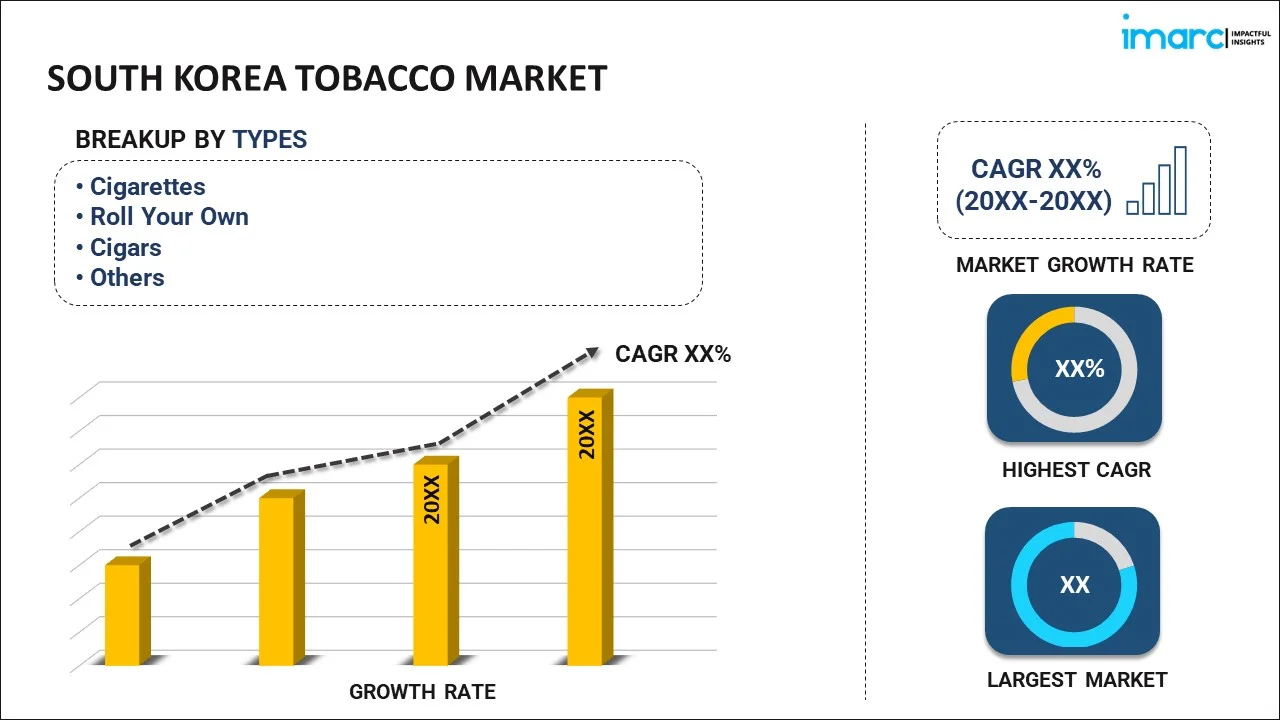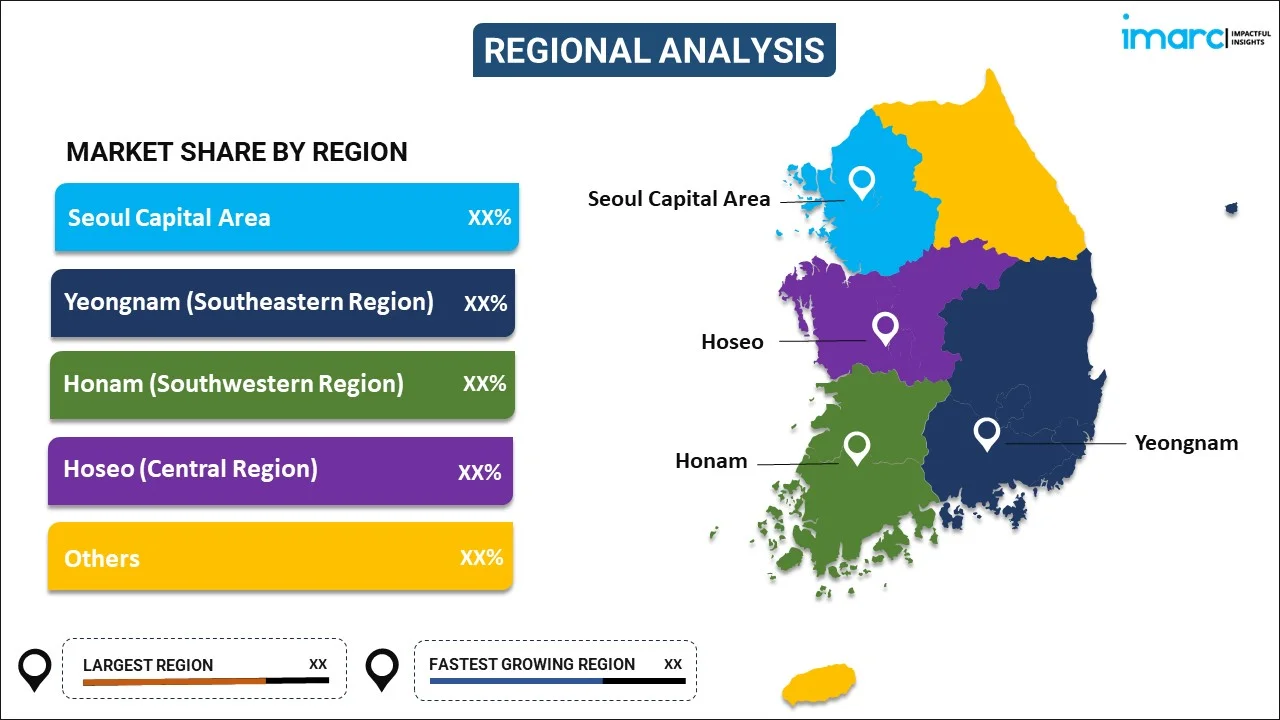
South Korea Tobacco Market Report by Type (Cigarettes, Roll Your Own, Cigars, Cigarillos, Smokeless Tobacco, and Others), and Region 2025-2033
Market Overview:
The south korea tobacco market size is projected to exhibit a growth rate (CAGR) of 2.12% during 2025-2033. The escalating demand for e-cigarettes, coupled with the widespread adoption of aggressive marketing and advertising strategies, is primarily driving the market growth across the country.
|
Report Attribute
|
Key Statistics
|
|---|---|
|
Base Year
|
2024 |
|
Forecast Years
|
2025-2033 |
|
Historical Years
|
2019-2024
|
| Market Growth Rate (2025-2033) | 2.12% |
Tobacco, scientifically known as nicotiana tabacum, is a plant primarily grown for its leaves containing the highly addictive alkaloid nicotine. Indigenous to the Americas, it has been traditionally used by native cultures. Various forms of consumption include cigarettes, cigars, pipe tobacco, and smokeless products like snuff and chewing tobacco. The cultivation process involves planting seeds in meticulously prepared fields, nurturing them into seedlings, and then transplanting them to larger fields where they reach maturity. The leaves undergo careful harvesting by hand and subsequent drying through methods such as air-curing, flue-curing, fire-curing, or sun-curing. Moreover, tobacco, due to its nicotine content, acts as a stimulant, triggering the release of neurotransmitters like dopamine, providing a pleasurable and relaxing sensation.
South Korea Tobacco Market Trends:
South Korea's tobacco market is influenced by a dynamic interplay of cultural traditions, changing consumer behaviors, and evolving regulatory landscapes. Despite a decline in smoking rates, this country still maintains a notable tobacco market driven by cultural acceptance and social norms. Additionally, the inflating popularity of diverse tobacco products, including cigarettes, cigars, and smokeless options, remains significant, which is acting as another significant growth-inducing factor. Besides this, anti-smoking campaigns and health awareness initiatives contribute to a shift in consumer preferences, with an increasing demand for reduced-risk products and smoking cessation aids, which is positively influencing the regional market. Moreover, the rise of electronic cigarettes (e-cigarettes) and heated tobacco products reflects the emerging trend, with South Korea adapting to these alternatives, thereby bolstering the market growth across the country. Apart from this, stringent regulations on advertising and packaging further impact the market, emphasizing health warnings and limiting promotional activities. As South Korea navigates the complexities of balancing cultural practices with health considerations, the tobacco market will continue to undergo transformations, incorporating both traditional and innovative elements in the coming years.
South Korea Tobacco Market Segmentation:
IMARC Group provides an analysis of the key trends in each segment of the market, along with forecasts at the country level for 2025-2033. Our report has categorized the market based on type.
Type Insights:

- Cigarettes
- Roll Your Own
- Cigars
- Cigarillos
- Smokeless Tobacco
- Others
The report has provided a detailed breakup and analysis of the market based on the type. This includes cigarettes, roll your own, cigars, cigarillos, smokeless tobacco, and others.
Regional Insights:

- Seoul Capital Area
- Yeongnam (Southeastern Region)
- Honam (Southwestern Region)
- Hoseo (Central Region)
- Others
The report has also provided a comprehensive analysis of all the major regional markets, which include Seoul Capital Area, Yeongnam (Southeastern Region), Honam (Southwestern Region), Hoseo (Central Region), and Others.
Competitive Landscape:
The market research report has also provided a comprehensive analysis of the competitive landscape. Competitive analysis such as market structure, key player positioning, top winning strategies, competitive dashboard, and company evaluation quadrant has been covered in the report. Also, detailed profiles of all major companies have been provided.
South Korea Tobacco Market Report Coverage:
| Report Features | Details |
|---|---|
| Base Year of the Analysis | 2024 |
| Historical Period | 2019-2024 |
| Forecast Period | 2025-2033 |
| Units | Billion USD |
| Scope of the Report | Exploration of Historical and Forecast Trends, Industry Catalysts and Challenges, Segment-Wise Historical and Predictive Market Assessment:
|
| Types Covered | Cigarettes, Roll Your Own, Cigars, Cigarillos, Smokeless Tobacco, Others |
| Regions Covered | Seoul Capital Area, Yeongnam (Southeastern Region), Honam (Southwestern Region), Hoseo (Central Region), Others |
| Customization Scope | 10% Free Customization |
| Post-Sale Analyst Support | 10-12 Weeks |
| Delivery Format | PDF and Excel through Email (We can also provide the editable version of the report in PPT/Word format on special request) |
Key Questions Answered in This Report:
- How has the South Korea tobacco market performed so far and how will it perform in the coming years?
- What has been the impact of COVID-19 on the South Korea tobacco market?
- What is the breakup of the South Korea tobacco market on the basis of type?
- What are the various stages in the value chain of the South Korea tobacco market?
- What are the key driving factors and challenges in the South Korea tobacco?
- What is the structure of the South Korea tobacco market and who are the key players?
- What is the degree of competition in the South Korea tobacco market?
Key Benefits for Stakeholders:
- IMARC’s industry report offers a comprehensive quantitative analysis of various market segments, historical and current market trends, market forecasts, and dynamics of the South Korea tobacco market from 2019-2033.
- The research report provides the latest information on the market drivers, challenges, and opportunities in the South Korea tobacco market.
- Porter's five forces analysis assist stakeholders in assessing the impact of new entrants, competitive rivalry, supplier power, buyer power, and the threat of substitution. It helps stakeholders to analyze the level of competition within the South Korea tobacco industry and its attractiveness.
- Competitive landscape allows stakeholders to understand their competitive environment and provides an insight into the current positions of key players in the market.
Need more help?
- Speak to our experienced analysts for insights on the current market scenarios.
- Include additional segments and countries to customize the report as per your requirement.
- Gain an unparalleled competitive advantage in your domain by understanding how to utilize the report and positively impacting your operations and revenue.
- For further assistance, please connect with our analysts.
 Request Customization
Request Customization
 Speak to an Analyst
Speak to an Analyst
 Request Brochure
Request Brochure
 Inquire Before Buying
Inquire Before Buying




.webp)




.webp)












